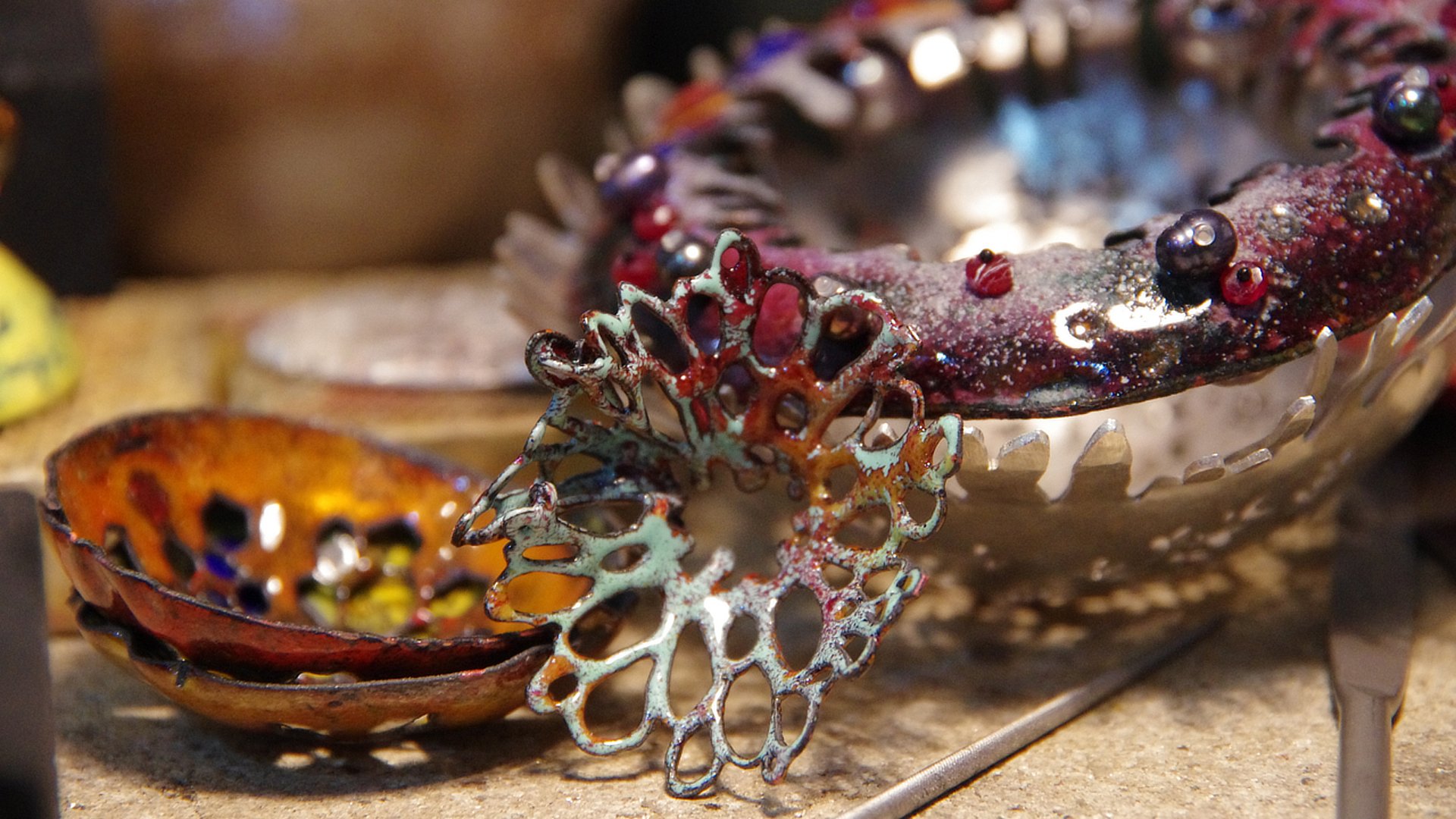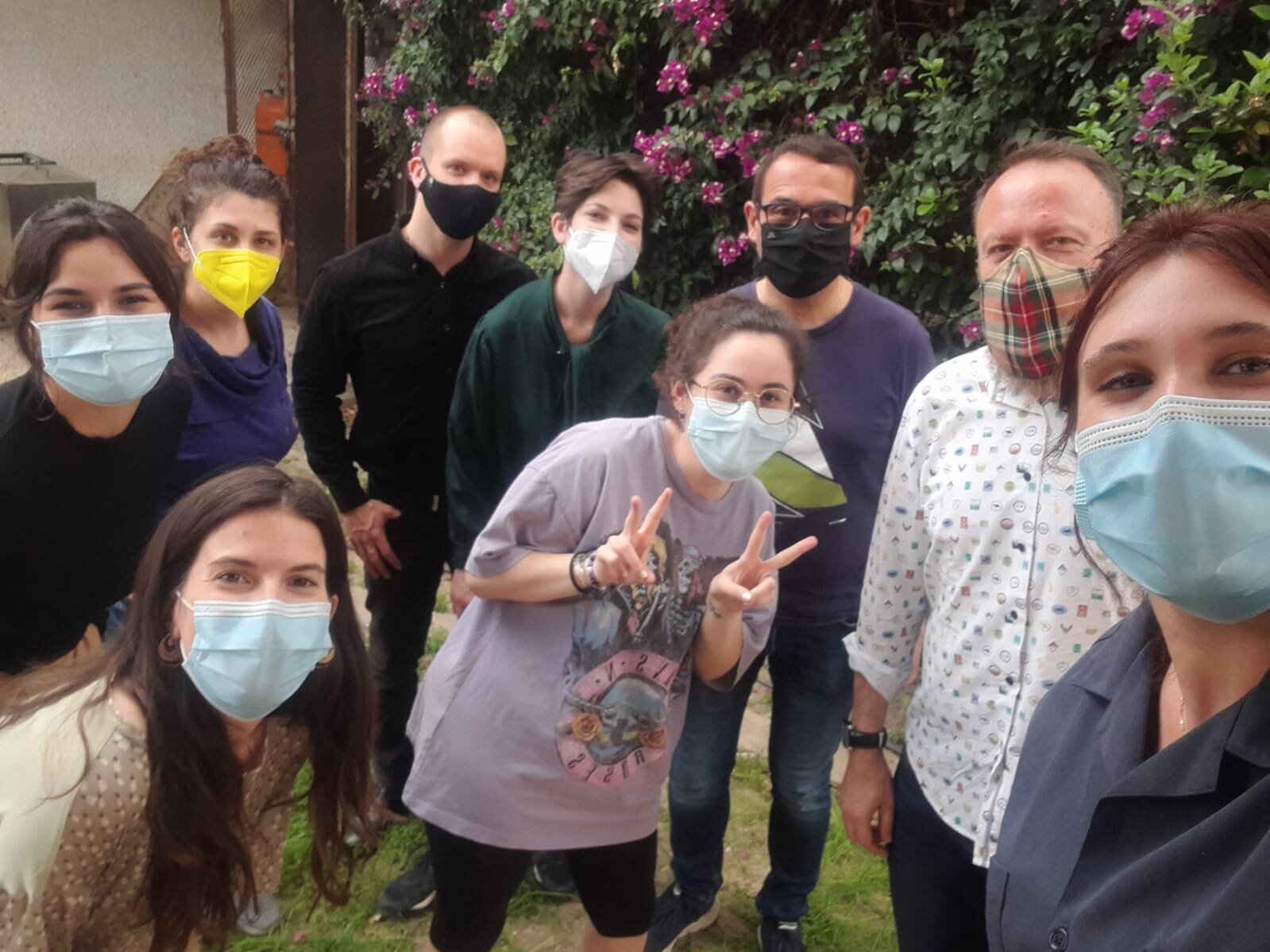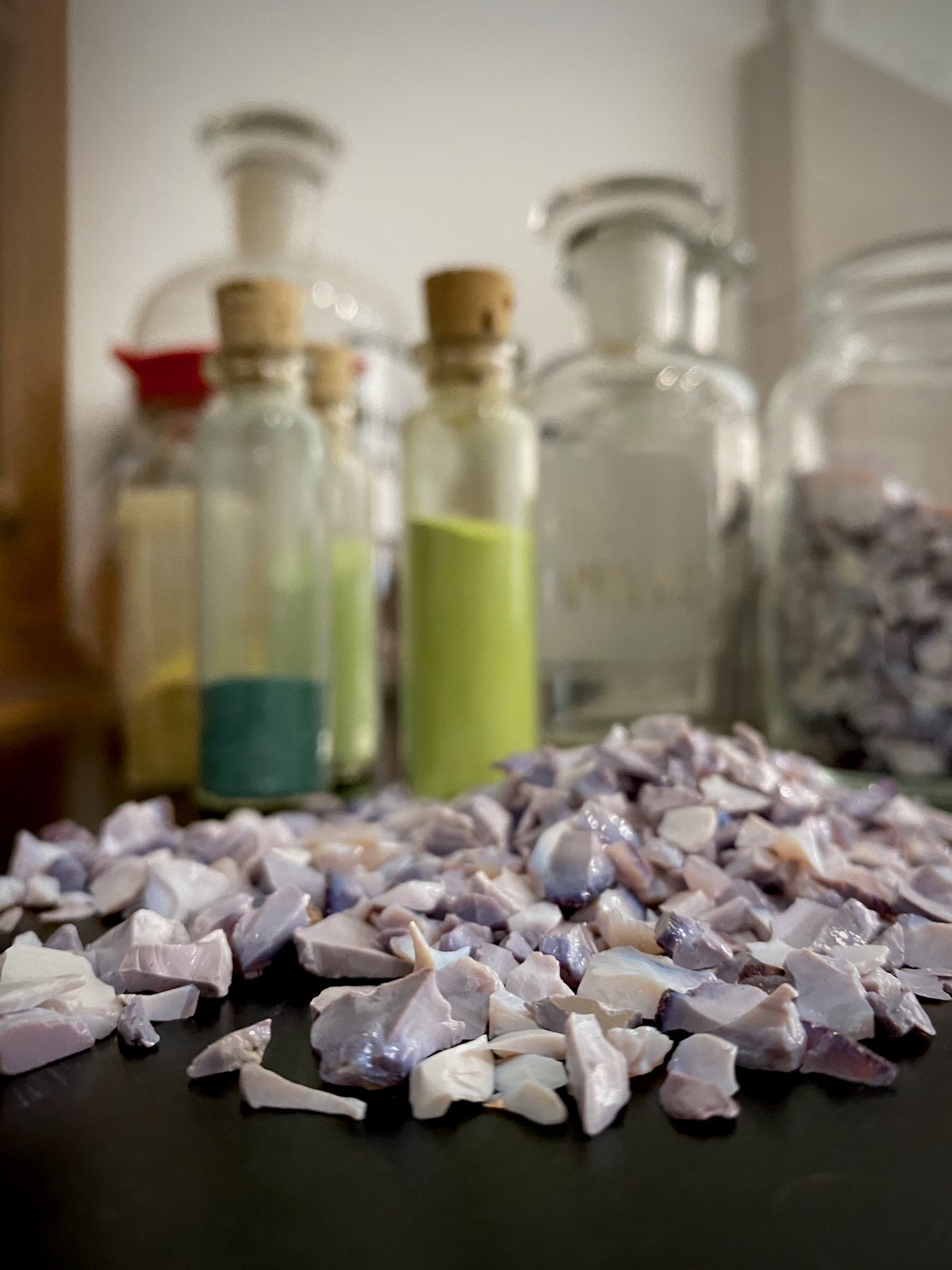
blog
Welcome to my blog. This is a place where I think out loud, show you what I’m up to in the studio, share impressions of inspiring events or everyday moments that moved me. Some entries are carefully curated essays, others are just a few thoughts, sometimes written in English and sometimes in German.
Featured posts

newest blog entries:
Sea Salt & Enamels: A Teaching Experience in Murcia
An enriching teaching experience at the Escuela de Arte de Murcia in Spain.
Teaching in Murcia
A teaching experience in the South of Spain.
Written in English.
Travelling during pandemic times is difficult, if not outright impossible. Usually, my job involves a fair amount of travelling and with that, the vibrant and joyful exchange of sharing a common passion in different cultural environments.
With those pale Covid-months stretching across a barren 2020, with no exhibitions, craft fairs, symposiums, workshops and other events to participate in, I feel almost starved of the exhilarating opportunity to exit my own bubble and taste some other reality elsewhere. Travelling, and more importantly, in-person contact with other creative minds, has become so rare that its value has increased dramatically.
So, an opportunity to teach a five-day enamelling workshop at the Escuela de Arte de Murcia this past week was a welcome and precious gift. The school, which actively encourages students to travel internationally via Erasmus exchanges and offers Erasmus staff mobilities to teachers and lecturers, focusses its jewellery course on contemporary art jewellery, especially exploring alternative materials and new techniques. In the midst of our bleak and never-ending lockdown, the jewellery department reached out to me and my partner Alvaro to travel to Murcia via an Erasmus mobility grant and teach a workshop there respectively; Alvaro’s course centring around creative wax modelling techniques for casting, and mine exploring a more experimental and perhaps intuitive approach to enamelling.
The region of Murcia is situated in Southern Spain, bordering Valencia and Andalusia, with the Mediterranean Sea to the East. Travelling to this light-bathed, unknown spot of land really did something for our souls – for both of us, there was an immediate shedding of the darkness that had muted our efforts to create something wholesome and bright during the winter.
Alvaro’s workshop explored a range of different wax-working techniques, starting with several distinct kinds of modelling wax with their own unique purpose each, and becoming more experimental with the inclusion of plastic objects and organic materials, emphasising the particular preparation of dried plant parts to enable proper casting. The workshop combined all these different wax-working techniques in a final project: creating a modern chimera, an imaginary beast, a creature of all walks of life giving voice to any pluralistic interpretation the students wished to express.
My workshop expanded on basic enamelling techniques with an experimental approach, starting with easier techniques such as dry-sifting and layering enamel, and working towards more complex techniques using vitreous enamel, foil or graphite. Finally, the course encouraged participants to create completely unique and often surprising enamel effects using sand, aluminium, fine silver, organic materials to burn in the kiln, or anything else that might cause a chemical reaction with interesting results during the firing process. The students were tasked to identity and express a particular emotion in their final pieces, one that no single word exists for and that can only be described by explaining the situation it is experienced in. The spectrum of emotions presented in the end – many of them dealing with our current Covid-19-situation – revealed just how rich and varied the scope of individual experiences can be.
To teach a alongside my partner Alvaro was a unique gift in itself. Even though we both have a history of diverse teaching experiences, this was the first time for us presenting workshops side by side, being able to discuss the studio set-up, the coherence of our planned activities, and the progress of our students. There was a sense of intense, creative flow, in unison. The tapas bar nights and extended walks through the city of Murcia were filled with conversations, ideas, plans for future projects. The unbelievable food experiences here were certainly also responsible for our enthusiasm: Tomatoes that tasted of ripe sun, and perfect olives, and the most exquisite fried octopus, sea food paella, oranges that were so fresh you could smell them from across the street, and everything augmented by the most umami sea salt (which is produced in this area of Spain near Cartagena) and toppiest top quality olive oil.
We vowed to find new way to keep chasing this positive energy and vibrant life force we felt here, not to allow others with a more negative disposition to drag us down back home.
An outing on the weekend to the beautiful Ricote Valley near the city of Murcia: Alvaro in an orchard of peach trees.
We began our workshops with a presentation of our own backgrounds, our work and its philosophical underpinnings.
Alvaro explaining different wax samples and their different uses.
It was incredibly rewarding to see the students become more and more bold and experimental in their work during my workshop.
Final presentation: The students show and discuss their test plates and final pieces.
Caught mid-explanation: Although the language barrier proved to be quite a challenge, we managed to explain, describe, translate and generally communicate in the most creative way. Definitely a rewarding and mind-expanding experience.
My wonderful course of second years for this workshop: On the far right is the jewellery department’s coordinator Noelia García Gallego, on the far left Verónica, who will visit my workshop as an Erasmus intern for two months this coming summer 2021.
Our workshops were followed by a boat trip on the river, organized by the school and our kind Erasmus coordinator, Rocío. Jakaranda trees, Oleander, figs and Tipuana tipus crowded the streets and brought back tender memories from my childhood garden in South Africa.
A local fresh produce market in Murcia, where every vegetable stall seemed to have at least sixteen different types of tomato for sale.
Blätterfresser
Die Blätterfresser erzählen vom tödlichen Leben, vom lebendigen Sterben. Sie erinnern daran, dass nichts ewig ist, und doch alles immer wiederkehrt. Daran, dass auch wir Narben und Fraßspuren sammeln, die oft nur den Überlebenswillen anderer Wesen auf unseren Körpern und Seelen markieren.
BlätterFresser
Die Geschichte meiner BlätterFresser/LeafEaters Kollektion.
Auf Deutsch.
Auf dem Unikampus, den ich täglich überquerte, entdeckte ich eines Tages eine Hecke mit von Insekten zerfressenen Blättern. Die löchrigen Fraßkanten bildeten ein filigranes Muster, das gleichzeitig von Leben und Tod erzählte. Manche Blätter zeigten nur ein paar verstreute Löcher wie zufällig fallen gelassene Perlen, andere waren bis auf ein Skelett abgenagt. Die Fraßspuren wurden beim längeren Hinsehen zum sich wiederholenden aber doch immer neu ausgeprägten Muster, zum Ornament.
Hier waren zwei Lebenswillen ineinander verzahnt: Ein kleines Knabberwesen auf der Suche nach Nahrung, und ein größeres Pflanzenwesen auf der Such nach Licht. Ich sah ein für unsere menschlichen Ohren stilles Drama, eine Geschichte von Geben und Nehmen und Überleben, vom Trotzen. In einer Zeit in der ich mich selber manchmal etwas un-heil fühlte, war ein Blatt, das Verletzungen wie Schmucknarben trug und doch lebte und funktionierte und photosyntierte, für mich ein starkes Symbol.
Ich schuf daraus die Kollektion Blätterfresser: Ohrringe, Broschen und Taschenglücksbringer, handgesägt aus Silber, Gold oder Kupfer, in bunt schillernden Farbtönen einzigartig emailliert. Bis heute sind viele Stücke für diese Kollektion entstanden, und jedes einzelne hat einen ganz individuellen Charakter.
Die Blätterfresser erzählen vom tödlichen Leben, vom lebendigen Sterben. Sie erinnern daran, dass nichts ewig ist, und doch alles immer wiederkehrt. Daran, dass auch wir Narben und Fraßspuren sammeln, die oft nur den Überlebenswillen anderer Wesen auf unseren Körpern und Seelen markieren.
Mit meinen hellgrünen Blätterfressern aus Gold und Emaille fühle ich mich stark. Sie erinnern daran, dass wir durch unsere löchrig gefressenen Lebensgeschichten manchmal sogar schöner, interessanter und vor allem eigener werden.
Eine Auftragsarbeit entsteht: Rote Blätterfresser als Anhänger, hier durch eine passgenaue Silberrückseite verstärkt, um das Emaille zu schützen.
Winzige fliederfarbene Blätterfresser mit Rubinen und schwarzen Süßwasserperlen auf dem Werkbrett; darüber verschiedene Arbeiten im Entstehen.
Hier eine Variante in leuchtendem Grün, verspielt und lebendig, mit facettierten Smaragdperlchen, Goldblättchen und Perlen vervollständigt.
Die von Hand gesägten Blätter werden versäubert.
Persönliche Lieblinge aus Gold und grünem Emaille, hier von Lydia Schröder fotografiert.
Das grüne Lieblingspaar auf einer Tusche- und Aquarellzeichnung.
Spätsommerliche Blätterfresser mit herbstlichem Einschlag.
Eine festlich gekleidete Trägerin mit ihren lila-rosé-bordeauxfarbenen Blätterfressern.
Mobilia Gallery Exhibition
Covid-19 has taught us artists and galleries to diversify our sales channels, and I am curious to see how this trend will evolve, which technologies prove to be useful and which are less helpful, which alternative methods of communication have the ability to truly touch people.
Mobilia Gallery
Exhibition titled JEWELLERY FROM ARCHITECTURE at Mobilia Gallery.
Written in English.
A small collection of my work is currently part of an exhibition at Mobilia Gallery in Cambridge, Massachusetts titled JEWELLERY FROM ARCHITECTURE. The gallery has created a delightful digital catalogue to accompany their exhibition. If you are interested to see it, please contact me or email Libby and Jo Anne directly at mobiliagallery@gmail.com. Alternatively, see the online design store Mobilia has put up on their website.
Covid-19 has taught us artists and galleries to diversify our sales channels, and I am curious to see how this trend will evolve, which technologies prove to be useful and which are less helpful, which alternative methods of communication have the ability to truly touch people. To me, it seems that the digital catalogues and online collections we are creating now also function as beautiful chronicles of the work we make, perhaps a sort of 21st century florilegium to gather and curate that which emerges from our creative practices.
Here is a screen shot of the gallery’s online display, and a selection of pieces specifically created for Mobilia Gallery:
Screen shot: Mobilia Gallery’s DESIGN STORE.
Red Closed Garden.
Pendant/Neckpiece. Vitreous enamel on copper, sterling silver (partially oxidized), orange-brown hand-stitched silk thread. Hand sawn, enamelled, fabricated.
Red Tilia.
Earrings. Vitreous enamel on copper, oxidised sterling silver hooks, black freshwater pearls, cubic zirconia drops, garnet, black nylon. Hand sawn, enamelled, fabricated, constructed.
Phoenix. Neckpiece. Vitreous enamel on copper, oxidized sterling silver clasp, silver cable, garnet, carnelian, onyx. Hand sawn, enamelled, fabricated.
Poeletjie II.
Brooch, also wearable as a pendant. Vitreous enamel on copper, sterling silver back, steel needle, faceted citrine and phrenite drops.Hand sawn, enamelled, fabricated.
Poeletjie III.
Brooch. Vitreous enamel on sterling silver, sterling silver back, steel needle, faceted phrenite drop. Hand sawn, enamelled, fabricated.
Tilia.
Earrings. Vitreous enamel on copper, sterling silver hooks, steel wire, citrine-smokey-quartz drops, peridot, pyrite, green garnet, 18 ct gold wire accents, nylon. Hand sawn, enamelled, fabricated, constructed.
Conscious Garden.
Brooch/Sculpture. Vitreous enamel on copper and sterling silver, blackened sterling silver back, steel needle, grey freshwater pearls, moss agate, and carnelian. Hand sawn, enamelled, fabricated, constructed.





































This summer, I have taken some time for deep thought to reflect on my most important beliefs underpinning my creative practice. I think of these nine concepts below as directional pointers for my inner creative compass. This is a deeply personal navigational tool for whenever the weather gets a little rough and stormy, and clear vision is impaired.